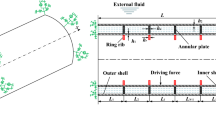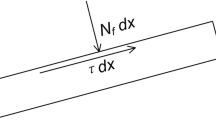Abstract
Energy flow analysis (EFA) can be used effectively to predict structural vibration in the medium-to-high frequency ranges. In this study, the energy flow finite element method (EFFEM), based on EFA, was used to predict the vibrations of a reinforced cylindrical structure in water. The predicted results of the vibrational energy density for the structure were compared with corresponding experimental results. The structure was divided into several subsystems in the experiment, with several accelerometers attached to each subsystem. The input power excited into the experimental structure was measured using an impedance-head adhered to an exciter. Measured input power was used to predict vibration of the reinforced cylindrical structure by EFFEM in water for comparing experimental and numerical results. A comparison between the experimental and predicted results for the vibrational energy density showed that EFFEM was an effective tool for predicting structural vibration.
Similar content being viewed by others
References
R. H. Lyon and R. G. Dejong, Theory and application of statistical energy analysis, Second edition, Butterworth-Heinemann (1995).
V. D. Belov, S. A. Rybak and B. D. Tartakovskii, Propagation of vibrational energy in absorbing structures, Soviet-Physics Acoustics, 23 (1977) 115–119.
D. J. Nefske and S. H. Sung, Power flow finite element analysis of dynamic systems: basic theory and application to beam, Journal of Vibration, Acoustics, Stress and Reliability in Design, 111 (1989) 94–100.
J. C. Wohlever and R. J. Bernhard, Mechanical energy flow models of rods and beams, Journal of Sound and Vibration, 153 (1992) 1–19.
O. M. Bouthier and R. J. Bernhard, Simple models of energy flow in vibrating membranes, Journal of Sound and Vibration, 182 (1995) 129–147.
O. M. Bouthier and R. J. Bernhard, Simple models of the energetics of transversely vibrating plates, Journal of Sound and Vibration, 182 (1995) 149–164.
D.-H. Park, S.-Y. Hong, H.-G. Kil and J.-J. Jeon, Power flow models and analysis of in-plane waves in finite coupled thin plates, Journal of Sound and Vibration, 244 (4) (2001) 651–668.
D.-H. Park, S.-Y. Hong and H.-G. Kil, Vibrational energy flow models of finite orthotropic plates, Shock and Vibration, 10 (2003) 97–113.
Y.-H. Park and S.-Y. Hong, Vibrational energy flow analysis of corrected flexural waves in Timoshenko beam — Part I: Theory of an energetic model, Shock and Vibration, 13 (2006) 137–165.
Y.-H. Park and S.-Y. Hong, Vibrational energy flow analysis of corrected flexural waves in Timoshenko beam — Part II: Application to coupled Timoshenko beams, Shock and Vibration, 13 (2006) 167–196.
J.-H. Song and S.-Y. Hong, Development of nonconservative joints in beam networks for vibration energy flow analysis, Shock and Vibration, 14 (2007) 15–28.
Y.-H. Park and S.-Y. Hong, Vibrational power flow models for transversely vibrating finite Mindlin plate, Journal of Sound and Vibration, 317 (2008) 800–840.
J.-H. Song, S.-Y. Hong, Y. Kang and H.-G. Kil, Vibrational energy flow analysis of penetration beam-plate coupled structures, Journal of Mechanical Science and Technology, 25 (3) (2011) 567–576.
H.-W. Kwon, S.-Y. Hong, D.-H. Park, H.-G. Kil and J.-H. Song, Vibrational energy flow models for out-of-plane waves in finite thin shell, Journal of Mechanical Science and Technology, 26 (3) (2012) 689–701.
P. E. Cho, Energy flow analysis of coupled structures, Ph. D. Thesis, Purdue University (1993).
N. Vlahopoulos, L. O. Garza-Rios and C. Mollo, Numerical implementation, validation, and marine applications of an energy finite element formulation, Journal of Ship Research, 43 (1999) 143–156.
S. Y. Hong, S. H. Seo, D. H. Park and H. G. Kil, Development of PFFEM based vibroacoustic prediction software- “PFADS”, NOVEM (2000).
S.-Y. Hong, H.-W. Kwon and Y.-H. Park, Development of energy flow analysis software for noise and vibration analysis, TEAM (2006).
S.-Y. Hong, J.-B. Han, J.-H. Song and H.-W. Kwon, Noise and vibration analysis programs based on energy flow methods, and Their Applications, NOVEM (2012).
F. Fahy, Sound and structural vibration, New York (1985).
I. Yoshiko, Prediction of structure borne sound transmission using statistical energy analysis, Bulletin of the M.E.S.J., 13 (2) (1985) 60–73.
Author information
Authors and Affiliations
Corresponding author
Additional information
Recommended by Associate Editor Cheolung Cheong
Hyun-Wung Kwon received his B.S. degree in Naval Architecture and Ocean Engineering from the Seoul National University, Korea, in 2004. He also received his Ph.D. from SNU in 2009. Currently, he is a professor at the Department of Shipbuilding at Koje College, Korea. His primary research interest is energy flow analysis in structures and acoustics.
Jee-Hun Song received his B.S. degree in Naval Architecture and Ocean Engineering from the Seoul National University, Korea, in 2003. He also received his Ph.D. from SNU in 2007. Currently, he is a professor of Naval Architecture and Ocean Engineering at Chonnam National University, Korea. His primary research interest is energy flow analysis in structures.
Rights and permissions
About this article
Cite this article
Kwon, HW., Hong, SY., Oh, DK. et al. Experimental study on the energy flow analysis of underwater vibration for the reinforced cylindrical structure. J Mech Sci Technol 28, 3405–3410 (2014). https://doi.org/10.1007/s12206-014-0404-z
Received:
Revised:
Accepted:
Published:
Issue Date:
DOI: https://doi.org/10.1007/s12206-014-0404-z




